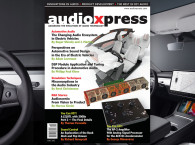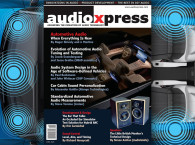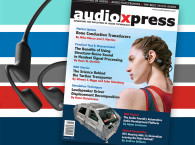 The June 2024 issue of audioXpress is now available and is focused on the evolving world of automotive audio and the new perspectives that are motivated by electric vehicles. To offer a broad perspective on all the things that are evolving, Roger Shively explains how automotive audio is shifting from hardware-dependent development as the industry embraces software-defined vehicles (SDV) and Artificial Intelligence (AI). As automotive companies and their suppliers are increasingly trying to develop technology that takes advantage of multimodal AI, how is this changing audio systems in the car, and what changes in the way audio systems and infotainment are designed?
The June 2024 issue of audioXpress is now available and is focused on the evolving world of automotive audio and the new perspectives that are motivated by electric vehicles. To offer a broad perspective on all the things that are evolving, Roger Shively explains how automotive audio is shifting from hardware-dependent development as the industry embraces software-defined vehicles (SDV) and Artificial Intelligence (AI). As automotive companies and their suppliers are increasingly trying to develop technology that takes advantage of multimodal AI, how is this changing audio systems in the car, and what changes in the way audio systems and infotainment are designed?As the software-defined car is currently one of the biggest transforming factors for the automotive industry, Philipp Paul Klose writes about Integrated Audio Development Frameworks that are available to the industry. These audio frameworks enable more time for actual innovation and less time to write code, debug, and test hardware deployment. But as the race is on to deliver a myriad of features on flexible, always connected hardware, it's also important to understand how these frameworks impact a flexible electronics system architecture and a solid software foundation for audio applications.
Next up, Jasper de Kruiff, David Speith, and Lukas Joas share their fascinating experience in crafting Immersive Driving Experiences for Electric Vehicles. Vehicle sound design is essential to ensure that the transition from combustion engines to electric power doesn't compromise the thrilling essence of driving. For this purpose, Impulse Audio Lab created EVx, a specialized software suite for the creation, tuning, and integration of dynamic, complex sounds, meeting the high standards of immersive sound design for electric vehicles (EVs). The article looks closer look at this specialized software suite and how it can enhance the thrilling essence of driving EVs.
Next, Ken Ward offers a different perspective on automotive audio in his article titled "Car Audio Tuning and Upgrading - The Crucial Question". As aftermarket car audio always needs to build on top of the audio systems that the manufacturers designed, the author and industry expert explains why this provides an opportunity to understand what works and what can be improved. A perspective that is always valuable for any designer.
And from the automotive use cases to a valuable perspective on modeling and simulation, this issue of audioXpress includes two articles by top industry experts, Jinlan Huang and René Christensen.
The first article by Jinlan Huang (COMSOL) explains how multiphysics modeling and simulation can be used to analyze electroacoustic transducers. Using a balanced armature transducer as example - a high-performance miniature loudspeaker often used in hearing aids and other in-ear audio products - the analysis combines the electromagnetic field with structural vibrations and acoustic radiation using multiphysics coupling features. A moving mesh is also used to model the back Electromotive Force (EMF) so that any effect on the coil impedance induced by the deforming air domain is captured. The article also details how to conduct a sub-modeling to extract lumped parameters that can be used to represent a sub-component and how to integrate the lumped sub-component model into a system analysis.

Expanding on his article series about Simulation Techniques, René Christensen writes about Dimensional Reduction for Vibroacoustical Simulations. As computational demands can be very high when doing simulations involving coupled physics - such as is often the case for vibroacoustical transducers - the article looks at how to reduce the computational demands and associated cost utilizing symmetry schemes and dimensional reductions techniques, and the potential associated issues.
This June issue also includes a practical test and measurement article, written by Steve Temme (Listen, Inc.) and Michael Ricci (xMEMS), detailing what we need to know about measuring MEMS microspeakers, a completely new class of product with its unique challenges. MEMS drivers are now commercially available and seeing fast evolution and adoption in true wireless stereo (TWS) earbuds and in-ear monitors (IEM). With the emergence of these small form-factor transducers comes the need to address how to measure its performance and ensure product quality, even before its integration in finished products.
For all audioXpress readers that felt inspired by the projects included in the May 2024 issue, there's an essential continuation in this June 2024 issue. Tim Mellow and Peter Farrow expand on their Low-Feedback Triode Amplifier with Zero Output Impedance (ZOI) project. The first part of this article introduced the Zero Output Impedance amplifier concept and discussed the design for a single-ended input version. In this second part, the design is extended to a balanced input configuration. Performance measurement figures are also discussed, and the article includes two Appendices that give detailed design calculations for both configurations.
And finally, Richard Honeycutt offers another irresistible take on Hollow-State Electronics, this time exploring the world of classic hifi before 1950. The term high-fidelity (later shortened to "hi-fidelity" and eventually just "hifi") was used as a marketing label in the 1950s to promote the difference in sound reproduction from the technologies available in previous decades. Yet, high fidelity was not exactly a new concept in home music playback systems. Broad frequency response and low distortion playback were not possible until the 1930s, and only in the late 1940s did affordable home music playback systems enter the market. In the US, at least 10 companies were instrumental in the hi-fidelity movement. Of these, a significant proportion offered at least some of their products in kit form.

All the content contained in every issue of audioXpress is the reason, month after month, 12 times per year, this publication continues to reinforce its role as an essential resource for the audio industry. Your support and that of our advertisers is what allows us to keep this publication in print and all digital platforms and pay our independent authors and contributors for their work.
Subscribe if you haven't done so yet in order not to miss future issues or renew your subscription. Subscribing to the digital online version allows immediate access and is available here: audioXpress Subscription Services
If you wish to buy a single printed issue or the complete audioXpress archive on USB, from 2000 to 2024 (yes, including the latest issue), just visit our online shop at www.cc-webshop.com
Don't miss out, get your copy of audioXpress right now at www.gotomyxpress.com






